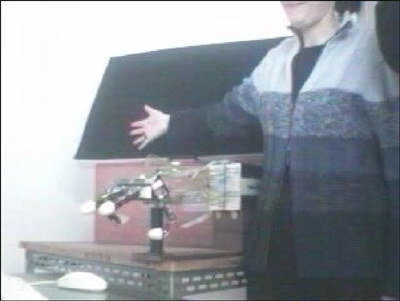At the robotic lab of the Palermo branch of ICAR CNR, a fruitful activity is currently dealing with the implementation of a human-machine interface based on human gestures. An anthropomorphic robotic hand (the DIST-Hand, made by GraalTech of Genova) and a low cost video acquisition system are the components of a platform for the experimentation of advanced and innovative methodologies. The system user shows his hand to the camera connected to a computer, executing some hand movements that are automatically interpreted and reconstructed. The robotic hand is able to act in two different ways:
- to imitate the showed movement, in this case we deal with tele-operation task, i.e. the remote execution of manipulations (for example when dangerous materials are handled or in the planetary exploration;
- to reply with a particular gesture, interacting with the user in order to execute collaborative tasks (for instance in hospital assistance, to support the rehabilitation of disabled or elderly people), to communicate (including orders to perform particular actions), or to play (for example, the Rock-Paper-Scissor game has been chosen to verify the system functionalities).
Such wide range of possible utilisation of the robotic hand arises from the adoption of a cognitive model based on Conceptual Spaces: multi-dimensional geometrical spaces that memorize relevant information as vectors called knoxels (knowledge pixels), used to compare objects, situations, actions related to the robotic system and the scene of the operations. The software architecture that derives from this model, also reconfigurable for other robotic systems, allows to manage in systematically way the different levels of knowledge involved in the computational processes: from sensorial data (cameras, sonar, infrared sensors, etc.), the information is organized by special structures which memorize only the necessary data and, allows high level reasoning (planning, symbolic description, interaction). In particular, the robotic hand system is able to adapt to the hand of different users, to complete or correct movements, it is accessible by computer network or internet. Current research activity, in collaboration with the Computer Science Department of the University of Palermo, is focused on the integration of the robotic hand with a robotic arm, in order to explore all the set of human gestures. Moreover, some interaction aspects involving emotional states are investigated (in collaboration with the Psychology Department of the University of Palermo) in order to have robotic systems acting as "humans" instead as "machines".
The research has been partially supported by some projects (for example RoboCare, a distributed robotic system to elderly support) and, is connected to the collaboration with other research centres such as the Italian Space Agency.
Vedi anche:
Immagini:




